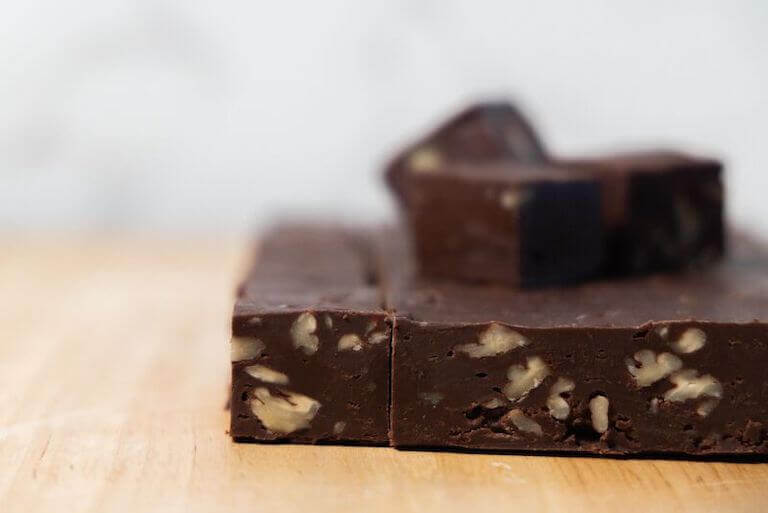Listen to This Article:
Loading the Elevenlabs Text to Speech AudioNative Player…
What’s not to love about fudge? It melts in your mouth, coating your tongue in rich and creamy sweetness.
However, making meltaway fudge isn’t always easy! If you don’t understand the proper techniques, you may end up with a grainy or crumbly rather than creamy confection.
If you want to get a better hold on making fudge, join us as we dive into some of the culinary science that pastry arts students can explore during their time at Escoffier.
How to Make Fudge
The simplest fudge recipes start with three ingredients found in many types of confections: sugar, butter, and milk. However, some recipes contain variations on these ingredients, like swapping sweetened condensed milk for the milk and sugar, or semi-sweet chocolate chips for some of the sugar.
Many types of fudge also contain additional ingredients like chocolate, vanilla, or maple syrup, as well as mix-ins such as nuts and marshmallows.
No matter the exact ingredients you use, the fudge-making process will be similar. First, you’ll heat the ingredients to dissolve the sugar and create a hom*ogenous mixture. Next, you’ll cook the mixture until it thickens. Finally, you’ll remove the fudge from the heat, allow it to cool, and then mix thoroughly.
Tips for Making Fudge
Smooth, creamy, and decadent fudge relies on proper technique, so keep these tips in mind when whipping up your next batch.
1. Monitor the Temperature with a Candy Thermometer
If you end up with soft fudge that turns into a puddle in your hands or hard fudge that is a bit reminiscent of a crunchy candy, improper temperature is likely to blame. If you don’t heat your fudge to a high enough temperature, you’ll end up with a soft product. And if you heat the mixture too much, your fudge may be harder than you’d like.
When you’re cooking your fudge over the stove, you should aim for a maximum temperature between 234-237ºF. Yes, that’s only a three-degree range! In order to ensure you remove your fudge from the heat as soon as it reaches this temperature, you should monitor the mixture with a candy thermometer.
2. Avoid Stirring Once the Mixture Comes to a Simmer
Another key part of a successful fudge texture is when you stir the mixture. Stirring the sugar and milk during the initial stages of cooking allows the sugar to dissolve. However, once the mixture comes to a boil, it’s time to put the spoon down.
If you continue stirring once the mixture is simmering, you are encouraging the development of sugar crystals. While crystallization is the goal if you’re making hard candy, crunchy sugar bits can quickly ruin a fudge’s silky smooth texture.
3. Beat Thoroughly
While you shouldn’t mix the fudge mixture when it’s hot, you should beat the mixture once it has been removed from the heat and cooled.
Once again, turn to your candy thermometer. When the mixture has cooled to 110ºF (but not a moment before), it’s time to pick up a wooden spoon and begin stirring. Continue mixing the fudge until it has lost most of its sheen, about 5–10 minutes.
If you mix the fudge when it’s too hot, the sugar particles may lump together and form discernable crystals. Therefore, monitoring the temperature is key!

Proper technique is an essential part of creating silky smooth fudge.
Chocolate Fudge Recipe
Keep the previous fudge tips in mind as you follow this recipe for chocolate fudge.
Ingredients
- 28 oz granulated sugar
- 12 oz whole milk
- 6 oz corn syrup
- 4 oz butter
- 5 oz unsweetened chocolate
- ¼ tsp salt
- 1 tbsp vanilla
Directions
- Prepare an 8×8 pan by lining it with butter-coated parchment paper or aluminum foil.
- Place the sugar, milk, and corn syrup in a medium saucepan and stir well. Once the mixture begins to boil, stop stirring. Monitor the mixture and watch for it to reach 230ºF.
- Add the butter, chocolate, salt, and vanilla and bring the temperature up to 235ºF. Remove from heat.
- Once the mixture has cooled to 110ºF, mix it with a wooden spoon until it loses the majority of its sheen.
- Pour the mixture into the prepared pan and let it cool fully before slicing.
Continue Improving Your Pastry Skills
Now that you know some of the tips for making fudge, it’s time to think about what other confections and baked goods you’d like to create! Whether you want to make a chewy yet tender loaf of bread or decorate a cake with smooth fondant and intricately piped roses, understanding the technique behind successful dishes is key.
Pastry school can introduce you to both the science and art involved in creating some of your favorite sweet treats and savory baked goods. By working with talented chef instructors, you can explore inside tricks and tips and receive individualized feedback as you practice creating new dishes.
By the time students graduate from , many find they are ready to move toward career goals like starting a bakery or beginning a career as a cake decorator. If you’d like to take the next step to accomplish your pastry dreams, contact us for more information.
To learn more about baking & pastry, check these out next:
- Cake Decorating Tips: How to Choose the Right Pastry Bag
- What Is It Like to Be a Pastry Chef?
- 6 Advanced Baking Techniques Every Pastry Chef Should Know
This article was originally published on December 25, 2016, and has since been updated.
*Information may not reflect every student’s experience. Results and outcomes may be based on several factors such as geographical region or previous experience.